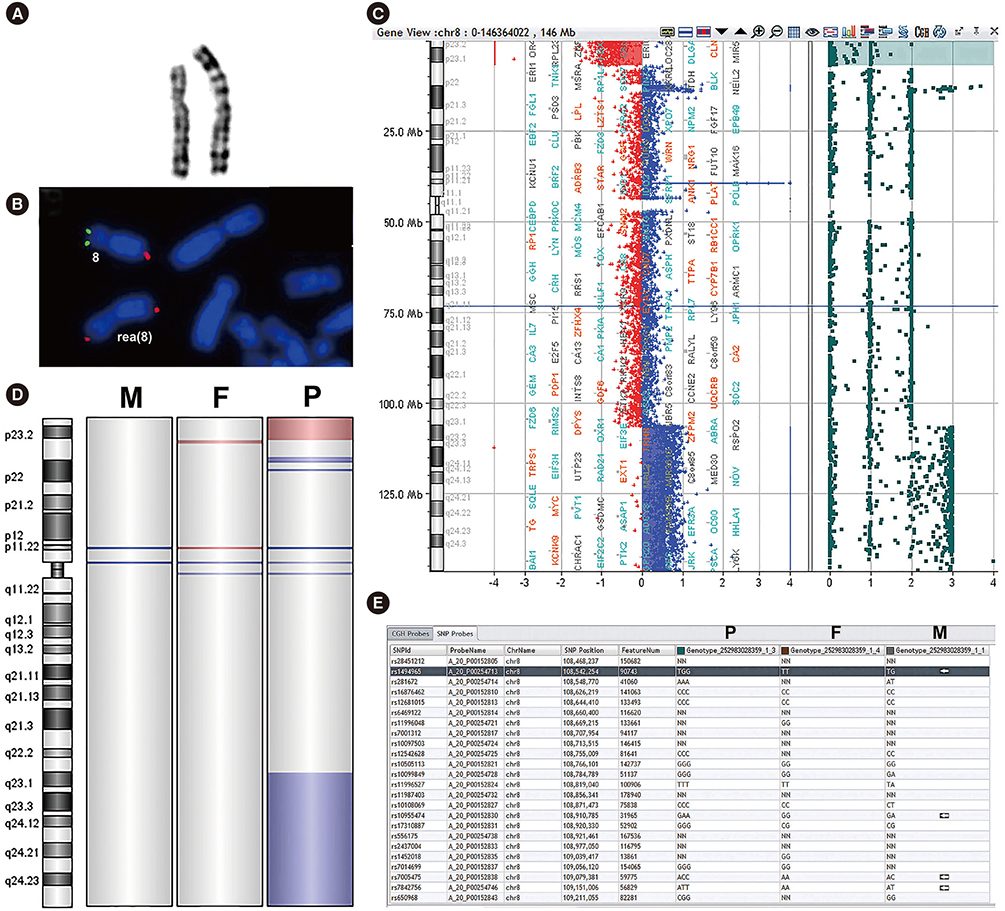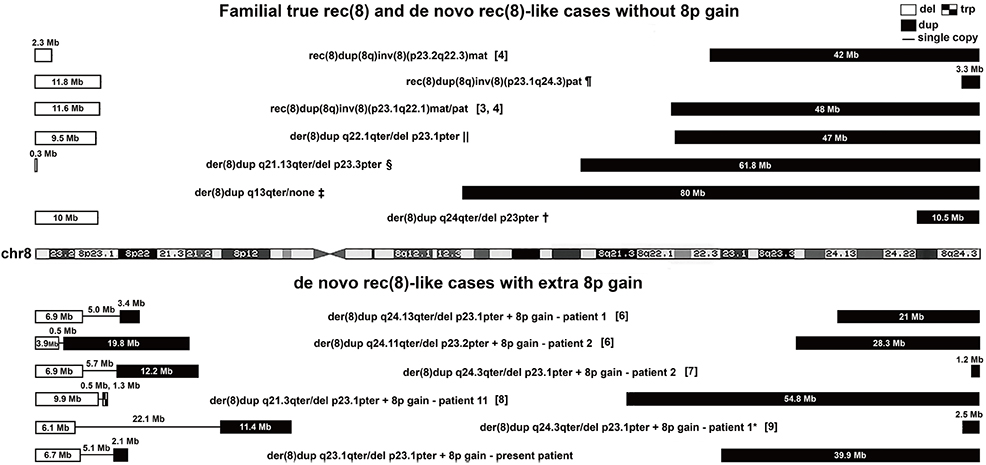Ann Lab Med.
2017 Jan;37(1):88-91. 10.3343/alm.2017.37.1.88.
De Novo San Luis Valley Syndrome-like der(8) Chromosome With a Concomitant dup(8p22) in a Mexican Girl
- Affiliations
-
- 1Centro de Investigación Biomédica de Occidente, Instituto Mexicano del Seguro Social, Guadalajara, Jal., México.
- 2BiologÃa Molecular y Genómica, Centro Universitario de Ciencias de la Salud, Universidad de Guadalajara, Guadalajara, Jal., México.
- 3Laboratorio de Citogenómica y Microarreglos, Departamento de BioquÃmica y Medicina Molecular, Facultad de Medicina, Universidad Autónoma de Nuevo León, Monterrey, N.L., México. carlos.cordovafl@uanl.edu.mx
- KMID: 2373623
- DOI: http://doi.org/10.3343/alm.2017.37.1.88
Abstract
- No abstract available.
MeSH Terms
Figure
Reference
-
1. Smith AC, Spuhler K, Williams TM, McConnell T, Sujansky E, Robinson A. Genetic risk for recombinant 8 syndrome and the transmission rate of balanced inversion 8 in the Hispanic population of the southwestern United States. Am J Hum Genet. 1987; 41:1083–1103.2. Pickler L, Wilson R, Tsai AC. Revisiting recombinant 8 syndrome. Am J Med Genet Part A. 2011; 155A:1923–1929.
Article3. Graw SL, Sample T, Bleskan J, Sujansky E, Patterson D. Cloning, sequencing, and analysis of inv8 chromosome breakpoints associated with recombinant 8 syndrome. Am J Hum Genet. 2000; 66:1138–1144.
Article4. Vera-Carbonell A, López-González V, Bafalliu JA, Piñero-Fernández J, Susmozas J, Sorli M, et al. Pre- and postnatal findings in a patient with a novel rec(8)dup(8q)inv(8)(p23.2q22.3) associated with San Luis Valley syndrome. Am J Med Genet Part A. 2013; 161A:2369–2375.
Article5. Rivera H, Domínguez MG, Vásquez-Velásquez AI, Lurie IW. De novo dup p/del q or dup q/del p rearranged chromosomes: review of 104 cases of a distinct chromosomal mutation. Cytogenet Genome Res. 2013; 141:58–63.
Article6. Buysse K, Antonacci F, Callewaert B, Loeys B, Fränkel U, Siu V, et al. Unusual 8p inverted duplication deletion with telomere capture from 8q. Eur J Med Genet. 2009; 52:31–36.
Article7. Yu S, Graf WD. Telomere capture as a frequent mechanism for stabilization of the terminal chromosomal deletion associated with inverted duplication. Cytogenet Genome Res. 2010; 129:265–274.
Article8. Kan AS, Lau ET, Tang WF, Chan SS, Ding SC, Chan KY, et al. Whole-genome array CGH evaluation for replacing prenatal karyotyping in Hong Kong. PLoS One. 2014; 9:e87988.
Article9. García-Santiago FA, Martínez-Glez V, Santos F, García-Miñaur S, Mansilla E, Meneses AG, et al. Analysis of invdupdel(8p) rearrangement: Clinical, cytogenetic and molecular characterization. Am J Med Genet Part A. 2015; 167A:1018–1025.
Article10. Cooke SL, Northup JK, Champaige NL, Zinser W, Edwards PA, Lockhart LH, et al. Molecular cytogenetic characterization of a unique and complex de novo 8p rearrangement. Am J Med Genet Part A. 2008; 146A:1166–1172.
Article
- Full Text Links
- Actions
-
Cited
- CITED
-
- Close
- Share
- Similar articles
-
- A Girl with 15q Overgrowth Syndrome and dup(15)(q24q26.3) that Included Telomeric Sequences
- A De Novo Unbalanced Translocation t (5;7) (q33;p22) Carrying Partial Trisomy 5q and Partial Monosomy 7p
- An unusual de novo duplication 10p/deletion 10q syndrome: The first case in Korea
- A Rare der(Y)t(Y;1)(q12;q12) in a Patient with Essential Thrombocythemia
- A Case of Dup (3q) Syndrome



